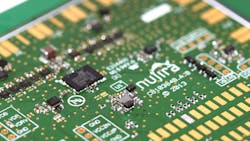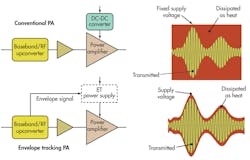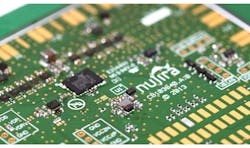Envelope Tracking Technology Boosts RF PA Linearity And Efficiency
Probably no other recent technology has done as much to improve the efficiency and linearity of RF power amplifiers (PAs) as envelope tracking (ET). And no other company has done as much to develop and make the technology practical and affordable as Nujira Ltd. While ET is not new, it is a tricky technology that Nujira has deployed to help make 4G LTE smart phones more efficient, providing greater battery life.
ET Concepts
Older 2G cell phones used modulation technologies that could be amplified by non-linear amplifiers that are far more efficient. Today with 3G and 4G technologies, linear amplifiers must be used to preserve the modulation content, which provides the speed required by demanding applications like video.
This file type includes high resolution graphics and schematics when applicable.
While linear PAs are readily available to do the job, their efficiency is poor. Class A or AB linear PAs rarely deliver efficiencies better than 25%, so considerable dc power is lost as heat. In addition, the overall higher power required shortens battery life, resulting in more frequent recharging.
Part of the problem lies in how linear PAs deliver their best efficiencies when they are operating in saturation. Known as compression, this occurs when the amplifier output begins to flatten when further input signal is applied. The optimum operating point is 1 dB less than the point where compression occurs.
The second part of the problem is that 3G and 4G signals like LTE have a high peak to average power ratio (PAPR), suggesting that the dynamic range of signals to be amplified is very wide. Orthogonal frequency-division multiplexing (OFDM) modulation used in LTE is particularly susceptible to high crest factors, producing multiple peaks and valleys of power. As a result, the amplifier spends a lot of time amplifying small signals where the power efficiency is low. With OFDM, as much as 80% of the PA dc power is wasted.
ET solves this problem. It varies the PA dc supply voltage to match the modulating signal level (Fig. 1). At peak signal levels, the dc collector or drain supply is high while the supply voltage is decreased at low signal levels. The result is that the PA is always operating near its optimum point for best efficiency.
An ET power supply modulator varies the supply. Nujira developed and perfected this technology. It improves efficiency and battery life while the amplifier remains linear, minimizing harmonics and intermodulation distortion (IMD).
While maintaining the amplifier in compression, digital pre-distortion (DPD) can further improve linearity. DPD takes a digital version of the signal and modifies it by an algorithm that compensates for any non-linearity. For example, an inverse function of the gain variation can correct any non-linearity in the PA gain caused by varying the supply voltage. This can be done in a lookup table.
A more comprehensive DPD technique samples the PA output with a fast analog-to-digital converter (ADC) and feeds the signal back to DPD circuitry that forms the correct inverse function to linearize the PA. DPD with ET provides the optimum level of linearity and power/heat reduction possible.
Signature Product
Nujira’s key product is the Coolteq.L NCT-L1300 ET power supply (ETPS). It is an alternative to common buck dc-dc converters used to power existing handset power amplifiers (Fig. 2). The IC tracks the baseband derived RF signal envelope and dynamically modulates the PA supply rail with wide bandwidth and tracking accuracy. The device maintains the PA in its highly efficient compressed state while providing constant gain despite any mismatched load. Its benefit is best in high peak-to-average-power ratio (PAPR) modulation schemes like WCDMA, HSPA, and OFDM.
The NCT-L1300 boasts an input voltage range of 2.5 to 5.25 V and an output voltage range of 0.5 to 5 V in a buck-boost circuit format. The rms output power in ET mode is 1.2 W. Efficiency is 80%. The device supports an average power tracking (APT) mode to maintain high system efficiencies at reduced RF transmit powers.
The control interface is the MIPI RFFE 1.1 standard two-wire serial interface. The operating mode of the IC, either ET or APT, is controlled with a single write-mode signal. The modulation input is analog differential compliant to the OpenET Class 2.0 specification. The device works with IC PAs with power levels up to 29 dBm and can potentially increase overall efficiency to the 40% to 50% range.
The basic bandwidth specification of the NCT-L1300 is less than 20 MHz, which is very useable even in LTE applications. However, this same part can achieve a bandwidth of 40 MHz. Nujira tested the device by transmitting a 200 resource block LTE waveform using the carrier aggregation feature of LTE-Advanced to achieve an instantaneous data rate of up to 150 Mbits/s. The test PA delivered 27-dBm output with an error vector magnitude (EVM) of 3% and an adjacent channel leakage ratio of –35 dBc.
The latest versions of the NCT-L1300 break the 50% efficiency level in LTE applications. It can achieve an adjacent channel performance of better than –50 dBc without DPD. The typical noise specification is –135 dBm/Hz. The fast mode switching lets the device support both TD-LTE and FD-LTE formats.
ET also can make CMOS PAs suitable for LTE. Most handset PAs are gallium arsenide (GaAs). They work well and most handsets use them, but they are expensive. CMOS PAs are available but have not proven to be linear enough for LTE. They are used in some 2G and 3G phones because of their low cost. Now combining an inexpensive CMOS PA with a Nujira ET chip creates an LTE-suitable PA. Recent Nujira tests indicate an adjacent channel leakage power ratio (ACLR) of –38 dBc with a 28-dBm CMOS amplifier achieving 57% efficiency.
A 16-band, multi-mode, multi-band ET reference design targets RF front ends for 4G smart phones. It uses the NCT-L1300 ET chip along with a minimum number of PAs to cover the wide range of LTE frequencies from 700 MHz to 2700 MHz. This makes it possible to greatly reduce the number of PAs but also provides a way to minimize the number of phone models to cover selected 3G and 4G bands.
Incidentally, while the signature part is the NCT-L1300, Nujira also makes an ET power modulator for LTE cellular basestations and remote radio heads. Designated the HCT-H4010, the module supports power levels to 60 W and provides an alternative to some of the Doherty PAs used in basestations to improve efficiency.
Finally, Global Cleantech 100 recently recognized Nujira for its energy savings products. This is the third year in a row that Nujira has received such recognition. Global Cleantech 100 is a list of companies with the most promising private environmentally friendly technology expected to have a significant impact on the market over the next five to 10 years.
About the Author

Lou Frenzel
Technical Contributing Editor
Lou Frenzel is a Contributing Technology Editor for Electronic Design Magazine where he writes articles and the blog Communique and other online material on the wireless, networking, and communications sectors. Lou interviews executives and engineers, attends conferences, and researches multiple areas. Lou has been writing in some capacity for ED since 2000.
Lou has 25+ years experience in the electronics industry as an engineer and manager. He has held VP level positions with Heathkit, McGraw Hill, and has 9 years of college teaching experience. Lou holds a bachelor’s degree from the University of Houston and a master’s degree from the University of Maryland. He is author of 28 books on computer and electronic subjects and lives in Bulverde, TX with his wife Joan. His website is www.loufrenzel.com.



